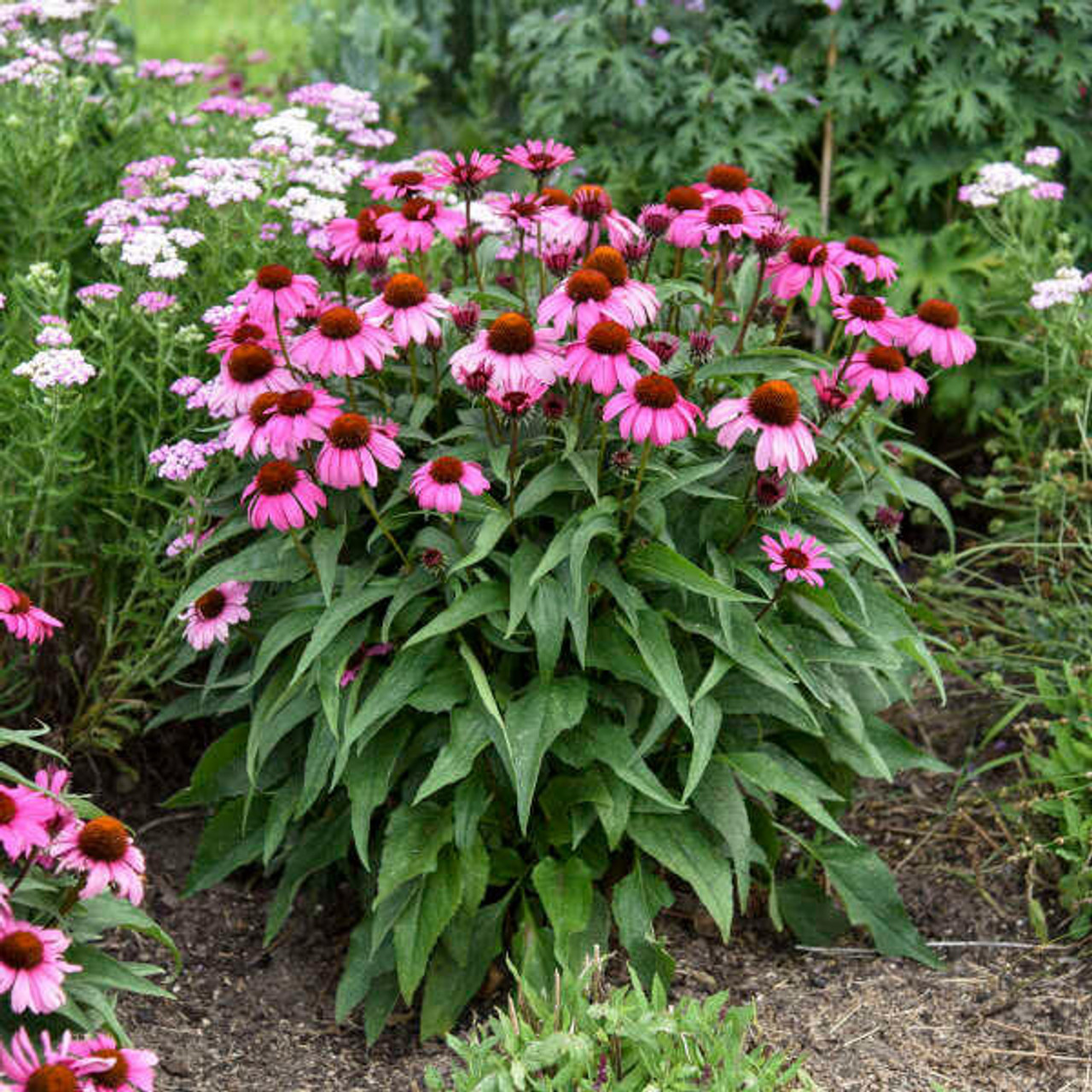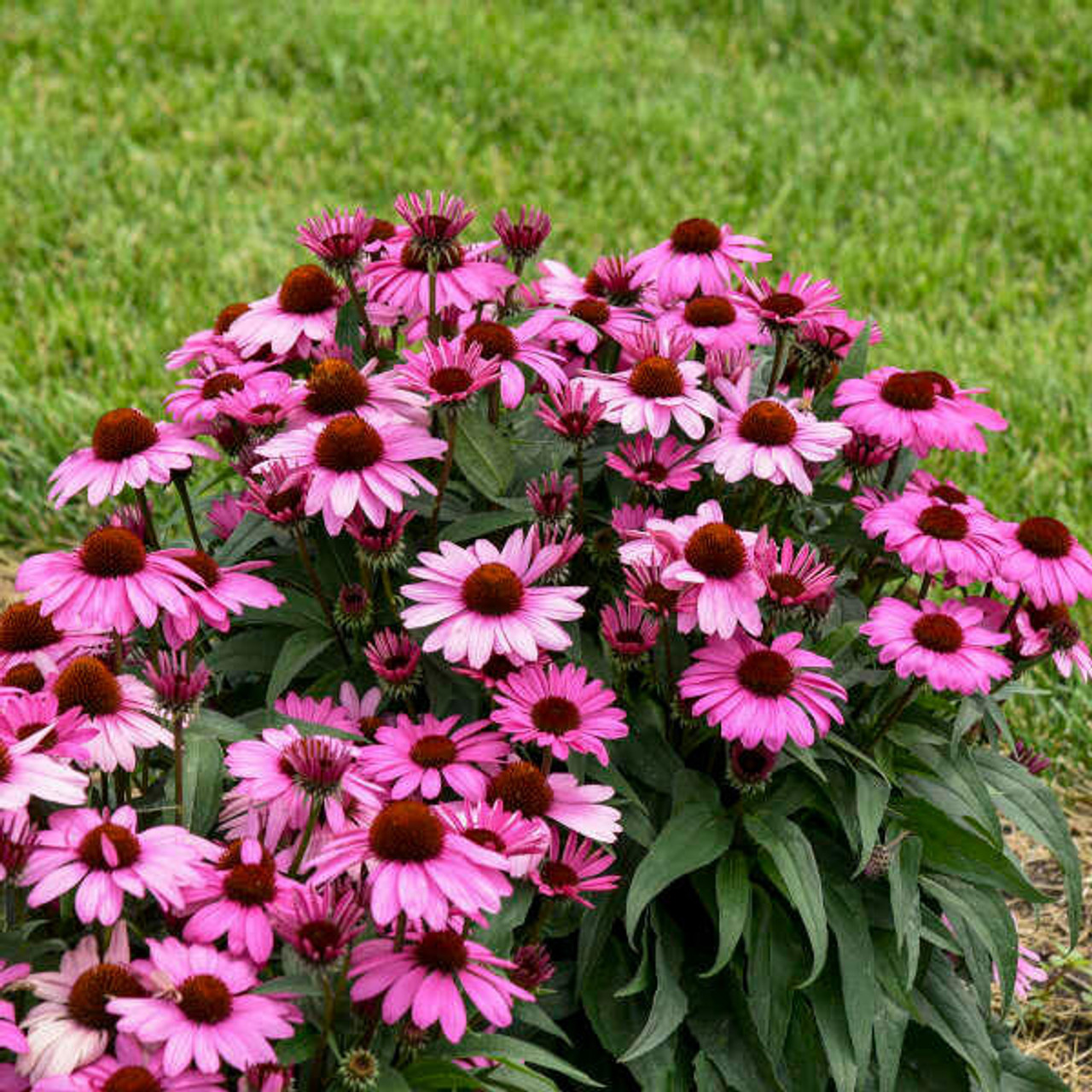Product Description
Echinacea 'The Fuchsia is Bright' PP35141 CPBRAF (30)ct Flat
COLOR CODED® Collection
Common Name: Coneflower
4½" fuchsia pink flowers are made of overlapping, horizontally held petals for an exceptionally showy display. The dark cone and stems of the plant contrast with the brightness of the petals, accentuating the vibrancy of the flowers. Exceptional garden performance.
COLOR CODED® Echinacea are produced vegetatively from tissue culture, so all plants will be identical in color and habit. These varieties were selected for their excellent basal branching, flower performance, large flower size, and horizontally held petals. Enjoy these as late summer interest for your garden. These are perfect pollinator magnets and during late fall to winter the seed heads will serve as food for birds.
Praised for their cheerful brightly colored flowers, coneflowers are a mainstay in today's garden. Be sure to leave some spent blooms on the plants in the fall because their seeds provide winter food for finches and other birds. The dried seed heads also provide architectural interest in the winter.
Coneflowers like it sunny and hot. Though they will tolerate light shade, fewer flowers will be produced, and the plants will be weakened. Light, loamy soils are best, but coneflowers will grow in any well-drained soil. Once established, they are quite drought tolerant. If properly cared for, they will form attractive colonies and will live for many years.
Height: 20.0-22.0 Inches
Spread: 16.0-18.0 Inches
Hardiness Zones: 4,5,6,7,8
Flower Color: Pink shades
Foliage Color: Green shades
Full Sun to Part Shade
Low to Average Water Needs
Poor to Fertile Soil Quality
Bloomtime: Midsummer to Late Summer
Deer Resistant
Seasonal Interest: Dried Seed Heads
Growth Rate: Medium
Border Plant, Container, Cut Flower, Dried Flower, Easy To Grow, Fragrant Flowers, Mass Planting
Echinacea 'The Fuchsia is Bright' is a vibrant and eye-catching coneflower that will add a burst of color to your garden. Here is a rundown of its key features and growing requirements:
Appearance:
- Flowers: As the name suggests, 'The Fuchsia is Bright' boasts large, vibrant fuchsia-pink flowers with a dark charcoal cone in the center. The petals are broad and overlapping, creating a full and showy appearance. The dark cone provides a striking contrast to the bright pink petals, adding to the overall visual appeal.
- Foliage: The plant features dark green, lance-shaped leaves that provide a nice backdrop to the vibrant flowers. The foliage is typically compact and bushy.
- Growth Habit: It has an upright, sturdy growth habit, typically reaching a height of 20-22 inches and spreading about 16-18 inches wide.
Growing Conditions:
- Light: Prefers full sun (at least 6 hours of direct sunlight) for optimal blooming.
- Soil: Thrives in well-drained soil. It can tolerate a range of soil types, including clay or sandy soils, as long as drainage is good.
- Hardiness Zones: Suitable for zones 4-8.
- Bloom Time: Flowers continuously from summer through fall, providing a long-lasting display of color.
Care:
- Watering: Water regularly, especially during the first year to establish roots. Once established, it is relatively drought-tolerant.
- Deadheading: Deadheading spent flowers encourages more blooms and helps to keep the plant looking tidy. However, leaving some seed heads in place provides food for birds in the winter and adds visual interest to the garden.
- Fertilizing: Generally, does not require heavy fertilization. A light application of a balanced fertilizer in spring can be beneficial.
- Pruning: Cut back the plant to the ground in late winter or early spring before new growth begins.
Uses:
- Excellent for adding vibrant color to borders, beds, and containers.
- Ideal for mass plantings to create a stunning visual impact.
- Suitable for cottage gardens, pollinator gardens, and cutting gardens.
- Makes beautiful cut flower arrangements.
- Attracts butterflies, bees, and other pollinators to the garden.
Additional Notes:
- Echinacea 'The Fuchsia is Bright' is a relatively low-maintenance plant that is easy to grow.
- It is deer-resistant, which is a bonus for gardeners in areas with deer populations.
- Consider pairing it with other sun-loving perennials like Coreopsis, Gaillardia, and Salvia for a colorful and long-blooming display.
Why Echinacea 'The Fuchsia is Bright' Stands Out:
- Vibrant Color: The bright fuchsia-pink flowers are exceptionally eye-catching and add a bold pop of color to the garden.
- Large Blooms: The flowers are relatively large for an Echinacea, making a significant visual impact.
- Long Bloom Time: It blooms continuously from summer through fall, providing a long-lasting display of color.
- Attracts Pollinators: It is a great choice for attracting butterflies, bees, and other beneficial insects to the garden.
If you are looking for a reliable and showy Echinacea to add to your garden, 'The Fuchsia is Bright' is an excellent choice. Its vibrant color, large blooms, long bloom time, and pollinator-friendly nature make it a winner for any landscape.
Thirty (30) plants per flat (or tray). Approximate Plug Measurements: 3 inches deep x 2 inches wide.
Other Details
The most important part of the plant is its root system. Healthy roots are the foundation of a healthy, vibrant plant. The type of plug container used is based on the specific needs of the plants. Perennials offered as bare root traditionally perform better when planted as bare root.Planted in a specialized mix, potted plants have well established root systems. Top growth stage will vary depending on the current life cycle and time of year when shipped. In Winter and early Spring dormant plants may be shipped. Dormant plants may be planted right away, even before the last frost date.
Most bare root varieties are field grown for at least one season, though Hemerocallis and Hosta are grown for two seasons. The bulk of the soil is removed during the harvesting process and the tops of most varieties are trimmed back to the crown. They are graded, packed in shredded aspen or sphagnum moss and stored in freezers until ready to be shipped.
See our Container Sizes and Bare Root Perennials pages for more information.
Plant information and care is provided in the Overview section, Plant Genus Page and general information is provided in the Planting Care & Guides. Additional questions can be asked on each Plant page.
Plant Spacing: Using the maximum mature spread or width of a plant to guide spacing, ensures space to grow to full size. To fill an area sooner, plant them closer together. Just remember, future thinning or transplanting may be needed.
Water: Keep a close eye on newly planted perennials, especially throughout the first growing year. Most early plant loss is due to too much or too little water!







